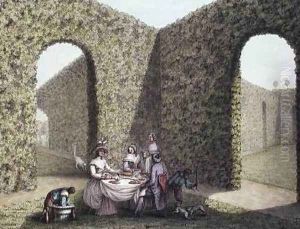Lequeu Paintings
Jean-Jacques Lequeu was a French architect and draftsman, born on September 14, 1757, in Rouen, France. Despite his relatively obscure life, Lequeu has come to be recognized as a significant figure in the history of architectural drawing and visionary architecture, bridging the gap between the neoclassical and the romantic. His career is a reflection of the tumultuous times in which he lived, spanning the final decades of the Ancien Régime, the French Revolution, and the Napoleonic era. Initially trained as an architect, Lequeu found little success in the profession, working mostly as a civil servant in the Ministry of the Interior.
Lequeu's legacy is anchored in his remarkable body of work, which was largely unknown during his lifetime. He possessed a unique talent for drawing and spent much of his life creating a vast array of architectural fantasies, detailed plans, and erotic illustrations. His work is characterized by an imaginative and often eccentric vision, with designs for fantastical buildings, gardens, and monuments that were never intended to be built. These drawings are notable for their technical skill, intricate detail, and the breadth of architectural knowledge they display.
Despite his lack of fame and fortune during his lifetime, Lequeu's work was rediscovered in the 20th century, leading to a reassessment of his contribution to architectural theory and drawing. His drawings were donated to the Bibliothèque nationale de France shortly before his death on March 28, 1826, in Paris. Today, Lequeu is celebrated for his visionary drawings that push the boundaries of architectural imagination, blending realism with fantasy, and for his contributions to the romantic movement in art. His work provides insight into the broader cultural and intellectual currents of his time, making him a fascinating study for art historians and architects alike.
